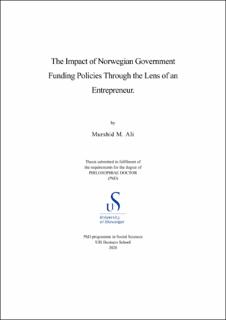| dc.contributor.advisor | Frick, Jan | |
| dc.contributor.advisor | Karlsen, James | |
| dc.contributor.author | Ali, Murshid M. | |
| dc.coverage.spatial | Norway | en_US |
| dc.date.accessioned | 2021-09-30T13:55:45Z | |
| dc.date.available | 2021-09-30T13:55:45Z | |
| dc.date.issued | 2021-09 | |
| dc.identifier.citation | The Impact of Norwegian Government Funding Policies Through the Lens of an Entrepreneur by Murshid M. Ali. Stavanger : University of Stavanger, 2021 (PhD thesis UiS 603) | en_US |
| dc.identifier.isbn | 978-82-8439-023-9 | |
| dc.identifier.issn | 1890-1387 | |
| dc.identifier.uri | https://hdl.handle.net/11250/2786709 | |
| dc.description.abstract | Norway, like many other industrialized countries, has a long tradition of implementing funding policies to shape and develop national innovation systems. These policies are often targeted at industries in which there is a sectoral competitive advantage, so leading to path dependency. Policymaking in Norway can be explained as a duality; policies implemented to correct market failures, targeted at small firms, and policies aimed at supporting national champions and upgrading existing technological capacities of selected industries. Existing studies on innovation systems and government funding policies often focus on top-down variables, and therefore fail to provide deeper insights on the effect of policymaking on company creation, regardless of path dependency. The aim of this study was to provide the perspective of an entrepreneur on the impact of government funding policies throughout a company lifecycle. This provided a hands-on contribution to the field, through active participation in and following five case companies and creating three companies.
These case companies fell within the categories of path dependency, path renewal and path creation. Three of the companies belonged to the oil and gas industry. We therefore assumed they were part of a sectoral innovation system, and path dependent. One was a financial technology company, representing path creation. The last company was a renewable energy company, which represented path renewal, government funding policies being mapped through interactions with both public and private actors. Findings suggest that the Norwegian government funding policies are strong in the first phases of a company lifecycle, but weak during growth and scaling. Policies are furthermore more likely to help entrepreneurs with existing networks, and therefore with the capability to leverage private funding. This study aimed to demystify the creation of a technology company, to help academics and policy makers understand the drivers behind creating and improving innovation in their region. | en_US |
| dc.language.iso | eng | en_US |
| dc.publisher | University of Stavanger, Norway | en_US |
| dc.relation.ispartofseries | PhD thesis UiS; | |
| dc.relation.ispartofseries | ;603 | |
| dc.rights | Navngivelse 4.0 Internasjonal | * |
| dc.rights.uri | http://creativecommons.org/licenses/by/4.0/deed.no | * |
| dc.subject | økonomi | en_US |
| dc.subject | gründer | en_US |
| dc.subject | innovasjon | en_US |
| dc.subject | offentlige finansieringsmuligheter | en_US |
| dc.subject | ny teknologi | en_US |
| dc.subject | Norge | en_US |
| dc.title | The Impact of Norwegian Government Funding Policies Through the Lens of an Entrepreneur | en_US |
| dc.type | Doctoral thesis | en_US |
| dc.rights.holder | ©2020 Murshid M. Ali | en_US |
| dc.subject.nsi | VDP::Social science: 200::Economics: 210::Business: 213 | en_US |

